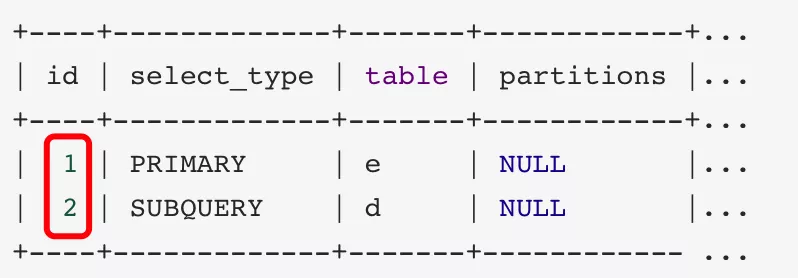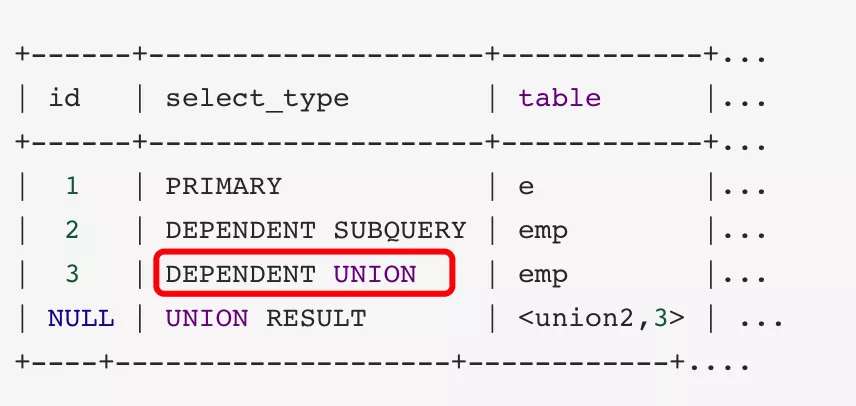 base de données
base de données
 tutoriel mysql
tutoriel mysql
 Apprentissage avancé MySQL : compréhension approfondie de la commande expliquer
Apprentissage avancé MySQL : compréhension approfondie de la commande expliquer
Apprentissage avancé MySQL : compréhension approfondie de la commande expliquer
Cet article est une étude avancée de MySQL. Il vous donnera une compréhension approfondie de la signification de chaque champ. J'espère qu'il vous sera utile !

À quoi sert expliquer : Afin de savoir comment optimiser l'exécution des instructions SQL, vous devez visualiser le processus d'exécution spécifique des instructions SQL pour accélérer l'efficacité d'exécution des instructions SQL.
Vous pouvez utiliser les instructions expliquer+SQL pour simuler l'optimiseur exécutant des instructions de requête SQL, afin de savoir comment MySQL traite les instructions SQL. Comprenez si l'exécuteur traite SQL comme nous le pensions en examinant le plan d'exécution.
Expliquez Les informations contenues dans le plan d'exécution sont les suivantes : id : numéro de séquence de requête
select_type : type de requête table : nom ou alias de la table partitions : partition correspondante type : type d'accès possible_keys : index éventuellement utilisés use using using using using using through through through through through through through through through through through through through through off ' s ' through ' ‐ ‐ ‐ ‐‐‐ ‐ ‐ ‐ ‐ ‐ ‐ ‐ ‐ ‐ ‐ ‐ ‐ ‐ ‐ ‐ ‐ ‐ ‐ ‐ ‐ ‐ ‐ ‐ ‐ ‐ ‐ ‐ ‐ ‐ ‐ ‐ ‐ ‐ ‐ ‐ ‐ ‐ ‐ ‐ ‐ ‐ ‐ ‐ ‐ ‐ ‐ ‐ ‐ ‐ ‐ ‐ ‐ ‐ ‐ ‐ ‐ ‐ ‐ ‐ ‐ ‐ ‐ ‐ ‐ ‐ ‐‐‐ ‐ ‐ Pourcentage Extra : Informations supplémentairesLe numéro de séquence (un ensemble de nombres) de la requête de sélection, qui représente l'ordre dans lequel la sélection est effectuée. une clause ou une opération de table est exécutée dans la requête. La colonne id est divisée en trois situations : 1. Si l'identifiant est le même, alors l'ordre d'exécution est de haut en basParlons de la signification de chaque colonne et du sql correspondant.
Le test utilise MySQL version 5.7. Les trois structures de table utilisées sont les suivantes
CREATE TABLE `demo`.`emp` ( `emp_id` bigint(20) NOT NULL, `name` varchar(20) CHARACTER SET utf8mb4 COLLATE utf8mb4_bin NULL DEFAULT NULL COMMENT '姓名', `empno` int(20) NOT NULL COMMENT '工号', `deptno` int(20) NOT NULL COMMENT '部门编号', `sal` int(11) NOT NULL DEFAULT 0 COMMENT '销售量', PRIMARY KEY (`emp_id`) USING BTREE, INDEX `u1`(`deptno`) USING BTREE, UNIQUE INDEX `u2`(`empno`) USING BTREE) ENGINE = InnoDB CHARACTER SET = utf8 COLLATE = utf8_bin ROW_FORMAT = Dynamic;Copier après la connexionCREATE TABLE `demo`.`dept` ( `id` bigint(20) NOT NULL, `deptno` int(20) NOT NULL COMMENT '部门编码', `dname` varchar(20) CHARACTER SET utf8 COLLATE utf8_bin NULL DEFAULT NULL COMMENT '部门名称', PRIMARY KEY (`id`) USING BTREE, UNIQUE INDEX `dept_u1`(`deptno`) USING BTREE) ENGINE = InnoDB CHARACTER SET = utf8 COLLATE = utf8_bin ROW_FORMAT = Dynamic;Copier après la connexionCREATE TABLE `demo`.`salgrade` ( `id` bigint(20) NOT NULL, `losal` int(20) NULL DEFAULT NULL, `hisal` int(20) NULL DEFAULT NULL, `emp_id` bigint(20) NULL DEFAULT NULL, PRIMARY KEY (`id`) USING BTREE) ENGINE = InnoDB CHARACTER SET = utf8 COLLATE = utf8_bin ROW_FORMAT = Dynamic;Copier après la connexioncolonne id
mysql> explain select * from emp e join dept d on e.deptno = d.deptno join salgrade sg on e.sal between sg.losal and sg.hisal;
mysql> explain select * from emp e where e.deptno = (select d.deptno from dept d where d.dname = 'SALES');
3. Des identifiants identiques et différents existent en même temps : les mêmes peuvent être considérés comme un groupe et sont exécutés séquentiellement de haut en bas. Dans tous les groupes, l'ID Plus la valeur est grande, plus la priorité est élevée et plus il est exécuté tôt
mysql> explain select * from emp e join dept d on e.deptno = d.deptno join salgrade sg on e.sal between sg.losal and sg.hisal wheree.deptno = (select d.deptno from dept d where d.dname = 'SALES');

select_type. column
 1.
1.
: Requête simple, hors sous-requêtes et union
mysql> explain select * from emp;
mysql> explain select * from emp e where e.deptno = (select d.deptno from dept d where d.dname = 'SALES');
3. union : La deuxième sélection et les suivantes dans union, union all et les sous-requêtes sont marquées comme union
mysql> explain select * from emp where deptno = 10 union select * from emp where sal >2000;

mysql> explain select * from emp e where e.empno in ( select empno from emp where deptno = 10 union select empno from emp where sal >2000)

mysql> explain select * from emp where deptno = 10 union select * from emp where sal >2000;

mysql> explain select * from emp where sal > (select avg(sal) from emp) ;

mysql> explain select e1.* from emp e1 WHERE e1.deptno = (SELECT deptno FROM emp e2 WHERE e1.empno = e2.empno);

mysql> explain select * from ( select emp_id,count(*) from emp group by emp_id ) e;

9. UNCACHEABLE SUBQUERY:一个子查询的结果不能被缓存,必须重新评估外链接的第一行对于外层的主表,子查询不可被物化,每次都需要计算(耗时操作)
mysql> explain select * from emp where empno = (select empno from emp where deptno=@@sort_buffer_size);

10. uncacheable union: 表示union的查询结果不能被缓存:没找到具体的sql语句验证.
table列
对应行正在访问哪一个表,表名或者别名,可能是临时表或者union合并结果集.
1、如果是具体的表名,则表明从实际的物理表中获取数据,当然也可以是表的别名.
2、表名是derivedN的形式,表示使用了id为N的查询产生的衍生表.
3、当有union result的时候,表名是union n1,n2等的形式,n1,n2表示参与union的id.
type列
type显示的是访问类型,访问类型表示我是以何种方式去访问我们的数据,最容易想的是全表扫描,直接暴力的遍历一张表去寻找需要的数据,效率非常低下。
访问的类型有很多,效率从最好到最坏依次是:
system > const > eq_ref > ref > fulltext > ref_or_null > index_merge > unique_subquery > index_subquery > range > index > ALL
一般情况下,要保证查询至少达到range级别,最好能达到ref
1. all: 全表扫描,需要扫描整张表,从头到尾找到需要的数据行。一般情况下出现这样的sql语句而且数据量比较大的话那么就需要进行优化。
mysql> explain select * from emp;

2. index:全索引扫描这个比all的效率要好,主要有两种情况,一种是当前的查询时覆盖索引,即我们需要的数据在索引中就可以索取,或者是使用了索引进行排序,这样就避免数据的重排序
mysql> explain select empno from emp;

3. range:表示利用索引查询的时候限制了范围,在指定范围内进行查询,这样避免了index的全索引扫描,适用的操作符:=, <>, >, >=, <, <=, IS NULL, BETWEEN, LIKE, or IN()
mysql> explain select * from emp where empno between 100 and 200;

4. index_subquery:利用索引来关联子查询,不再扫描全表
mysql> explain select * from emp where deptno not in (select deptno from emp)
但是大多数情况下使用SELECT子查询时,MySQL查询优化器会自动将子查询优化为联表查询,因此 type 不会显示为 index_subquery,而是ref

5. unique_subquery: 该连接类型类似于index_subquery,使用的是唯一索引
mysql> explain SELECT * from emp where emp_id not in (select emp.emp_id from emp );
大多数情况下使用SELECT子查询时,MySQL查询优化器会自动将子查询优化为联表查询,因此 type 不会显示为 index_subquery,而是eq_ref

6. index_merge:在查询过程中需要多个索引组合使用.
mysql> 没有模拟出来
7. ref_or_null:对于某个字段即需要关联条件,也需要null值的情况下,查询优化器会选择这种访问方式.
mysql> 没模拟出来
8. ref:使用了非唯一性索引进行数据的查找
mysql> explain select * from emp where deptno=10;

9. eq_ref :当进行等值联表查询使用主键索引或者唯一性非空索引进行数据查找(实际上唯一索引等值查询type不是eq_ref而是const)
mysql> explain select * from salgrade s LEFT JOIN emp e on s.emp_id = e.emp_id;

10. const:最多只能匹配到一条数据,通常使用主键或唯一索引进行等值条件查询
mysql> explain select * from emp where empno = 10;

11. system:表只有一行记录(等于系统表),这是const类型的特例,平时不会出现,不需要进行磁盘io
mysql> explain SELECT * FROM `mysql`.`proxies_priv`;

possible_keys列
显示可能应用在这张表中的索引,一个或多个,查询涉及到的字段上若存在索引,则该索引将被列出,但不一定被查询实际使用。
key列
实际使用的索引,如果为null,则没有使用索引,查询中若使用了覆盖索引,则该索引和查询的select字段重叠。
key_len列
表示索引中使用的字节数,可以通过key_len计算查询中使用的索引长度,在不损失精度的情况下长度越短越好。
索引越大占用存储空间越大,这样io的次数和量就会增加,影响执行效率
ref列
显示之前的表在key列记录的索引中查找值所用的列或者常量
rows列
根据表的统计信息及索引使用情况,大致估算出找出所需记录需要读取的行数,此参数很重要,直接反应的sql找了多少数据,在完成目的的情况下越少越好。
filtered列
针对表中符合某个条件(where子句或者联接条件)的记录数的百分比所做的一个悲观估算。
extra列
包含额外的信息。
1. using filesort: 说明mysql无法利用索引进行排序,只能利用排序算法进行排序,会消耗额外的位置
mysql> explain select * from emp order by sal;

2. using temporary: 建立临时表来保存中间结果,查询完成之后把临时表删除
mysql> explain select name,count(*) from emp where deptno = 10 group by name;

3. using index: 这个表示当前的查询是覆盖索引的,直接从索引中读取数据,而不用访问数据表。如果同时出现using where 表名索引被用来执行索引键值的查找,如果没有,表面索引被用来读取数据,而不是真的查找
mysql> explain select deptno,count(*) from emp group by deptno limit 10;

4. using where: 使用where进行条件过滤
mysql> explain select * from emp where name = 1;
5. using join buffer: 使用连接缓存
mysql> explain select * from emp e left join dept d on e.deptno = d.deptno;
6. impossible where:where语句的结果总是false
mysql> explain select * from emp where 1=0;
更多编程相关知识,请访问:编程视频!!
Ce qui précède est le contenu détaillé de. pour plus d'informations, suivez d'autres articles connexes sur le site Web de PHP en chinois!

Outils d'IA chauds

Undresser.AI Undress
Application basée sur l'IA pour créer des photos de nu réalistes

AI Clothes Remover
Outil d'IA en ligne pour supprimer les vêtements des photos.

Undress AI Tool
Images de déshabillage gratuites

Clothoff.io
Dissolvant de vêtements AI

AI Hentai Generator
Générez AI Hentai gratuitement.

Article chaud

Outils chauds

Bloc-notes++7.3.1
Éditeur de code facile à utiliser et gratuit

SublimeText3 version chinoise
Version chinoise, très simple à utiliser

Envoyer Studio 13.0.1
Puissant environnement de développement intégré PHP

Dreamweaver CS6
Outils de développement Web visuel

SublimeText3 version Mac
Logiciel d'édition de code au niveau de Dieu (SublimeText3)
 MySQL: Concepts simples pour l'apprentissage facile
Apr 10, 2025 am 09:29 AM
MySQL: Concepts simples pour l'apprentissage facile
Apr 10, 2025 am 09:29 AM
MySQL est un système de gestion de base de données relationnel open source. 1) Créez une base de données et des tables: utilisez les commandes CreateDatabase et CreateTable. 2) Opérations de base: insérer, mettre à jour, supprimer et sélectionner. 3) Opérations avancées: jointure, sous-requête et traitement des transactions. 4) Compétences de débogage: vérifiez la syntaxe, le type de données et les autorisations. 5) Suggestions d'optimisation: utilisez des index, évitez de sélectionner * et utilisez les transactions.
 Comment ouvrir phpmyadmin
Apr 10, 2025 pm 10:51 PM
Comment ouvrir phpmyadmin
Apr 10, 2025 pm 10:51 PM
Vous pouvez ouvrir PHPMYADMIN via les étapes suivantes: 1. Connectez-vous au panneau de configuration du site Web; 2. Trouvez et cliquez sur l'icône PHPMYADMIN; 3. Entrez les informations d'identification MySQL; 4. Cliquez sur "Connexion".
 Comment créer Navicat Premium
Apr 09, 2025 am 07:09 AM
Comment créer Navicat Premium
Apr 09, 2025 am 07:09 AM
Créez une base de données à l'aide de NAVICAT Premium: Connectez-vous au serveur de base de données et entrez les paramètres de connexion. Cliquez avec le bouton droit sur le serveur et sélectionnez Créer une base de données. Entrez le nom de la nouvelle base de données et le jeu de caractères spécifié et la collation. Connectez-vous à la nouvelle base de données et créez le tableau dans le navigateur d'objet. Cliquez avec le bouton droit sur le tableau et sélectionnez Insérer des données pour insérer les données.
 MySQL: une introduction à la base de données la plus populaire au monde
Apr 12, 2025 am 12:18 AM
MySQL: une introduction à la base de données la plus populaire au monde
Apr 12, 2025 am 12:18 AM
MySQL est un système de gestion de la base de données relationnel open source, principalement utilisé pour stocker et récupérer les données rapidement et de manière fiable. Son principe de travail comprend les demandes des clients, la résolution de requête, l'exécution des requêtes et les résultats de retour. Des exemples d'utilisation comprennent la création de tables, l'insertion et la question des données et les fonctionnalités avancées telles que les opérations de jointure. Les erreurs communes impliquent la syntaxe SQL, les types de données et les autorisations, et les suggestions d'optimisation incluent l'utilisation d'index, les requêtes optimisées et la partition de tables.
 Comment créer une nouvelle connexion à MySQL dans Navicat
Apr 09, 2025 am 07:21 AM
Comment créer une nouvelle connexion à MySQL dans Navicat
Apr 09, 2025 am 07:21 AM
Vous pouvez créer une nouvelle connexion MySQL dans NAVICAT en suivant les étapes: ouvrez l'application et sélectionnez une nouvelle connexion (CTRL N). Sélectionnez "MySQL" comme type de connexion. Entrez l'adresse Hostname / IP, le port, le nom d'utilisateur et le mot de passe. (Facultatif) Configurer les options avancées. Enregistrez la connexion et entrez le nom de la connexion.
 Pourquoi utiliser MySQL? Avantages et avantages
Apr 12, 2025 am 12:17 AM
Pourquoi utiliser MySQL? Avantages et avantages
Apr 12, 2025 am 12:17 AM
MySQL est choisi pour ses performances, sa fiabilité, sa facilité d'utilisation et son soutien communautaire. 1.MySQL fournit des fonctions de stockage et de récupération de données efficaces, prenant en charge plusieurs types de données et opérations de requête avancées. 2. Adoptez l'architecture client-serveur et plusieurs moteurs de stockage pour prendre en charge l'optimisation des transactions et des requêtes. 3. Facile à utiliser, prend en charge une variété de systèmes d'exploitation et de langages de programmation. 4. Avoir un solide soutien communautaire et fournir des ressources et des solutions riches.
 Comment utiliser un seul fileté redis
Apr 10, 2025 pm 07:12 PM
Comment utiliser un seul fileté redis
Apr 10, 2025 pm 07:12 PM
Redis utilise une architecture filetée unique pour fournir des performances élevées, une simplicité et une cohérence. Il utilise le multiplexage d'E / S, les boucles d'événements, les E / S non bloquantes et la mémoire partagée pour améliorer la concurrence, mais avec des limites de limitations de concurrence, un point d'échec unique et inadapté aux charges de travail à forte intensité d'écriture.
 MySQL et SQL: Compétences essentielles pour les développeurs
Apr 10, 2025 am 09:30 AM
MySQL et SQL: Compétences essentielles pour les développeurs
Apr 10, 2025 am 09:30 AM
MySQL et SQL sont des compétences essentielles pour les développeurs. 1.MySQL est un système de gestion de base de données relationnel open source, et SQL est le langage standard utilisé pour gérer et exploiter des bases de données. 2.MySQL prend en charge plusieurs moteurs de stockage via des fonctions de stockage et de récupération de données efficaces, et SQL termine des opérations de données complexes via des instructions simples. 3. Les exemples d'utilisation comprennent les requêtes de base et les requêtes avancées, telles que le filtrage et le tri par condition. 4. Les erreurs courantes incluent les erreurs de syntaxe et les problèmes de performances, qui peuvent être optimisées en vérifiant les instructions SQL et en utilisant des commandes Explication. 5. Les techniques d'optimisation des performances incluent l'utilisation d'index, d'éviter la numérisation complète de la table, d'optimiser les opérations de jointure et d'améliorer la lisibilité du code.







